Apple's Dominance Over Nokia
VerifiedAdded on 2020/03/23
|7
|1884
|62
AI Summary
This assignment explores the reasons behind Apple's success and Nokia's downfall in the smartphone market. It examines Apple's superior planning, organization, leadership, and control strategies compared to Nokia's more reserved approach. The case study highlights how Apple's focus on user experience and platform strategy contributed to its market dominance. It emphasizes the importance of effective management practices for businesses seeking success in competitive environments.
Contribute Materials
Your contribution can guide someone’s learning journey. Share your
documents today.
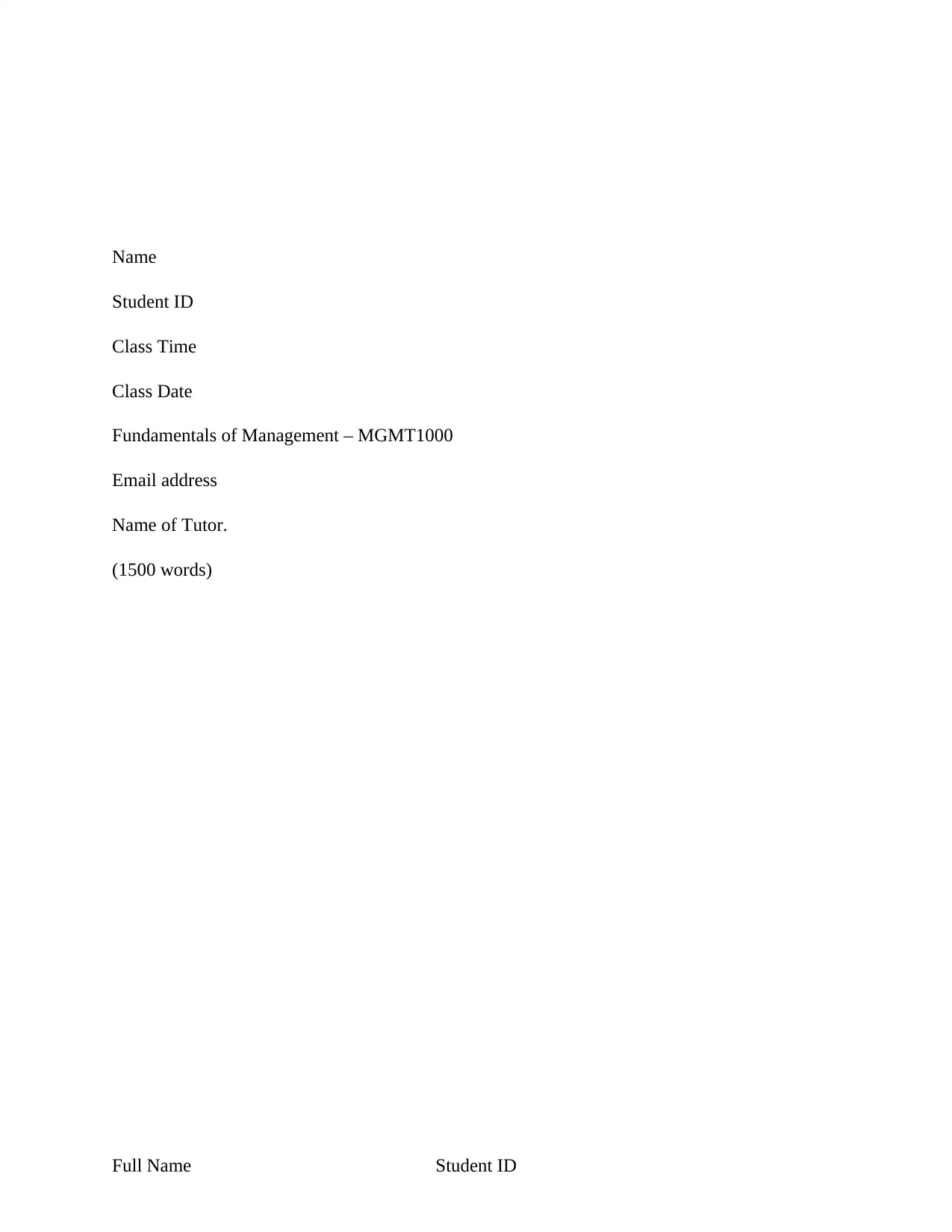
Name
Student ID
Class Time
Class Date
Fundamentals of Management – MGMT1000
Email address
Name of Tutor.
(1500 words)
Full Name Student ID
Student ID
Class Time
Class Date
Fundamentals of Management – MGMT1000
Email address
Name of Tutor.
(1500 words)
Full Name Student ID
Secure Best Marks with AI Grader
Need help grading? Try our AI Grader for instant feedback on your assignments.
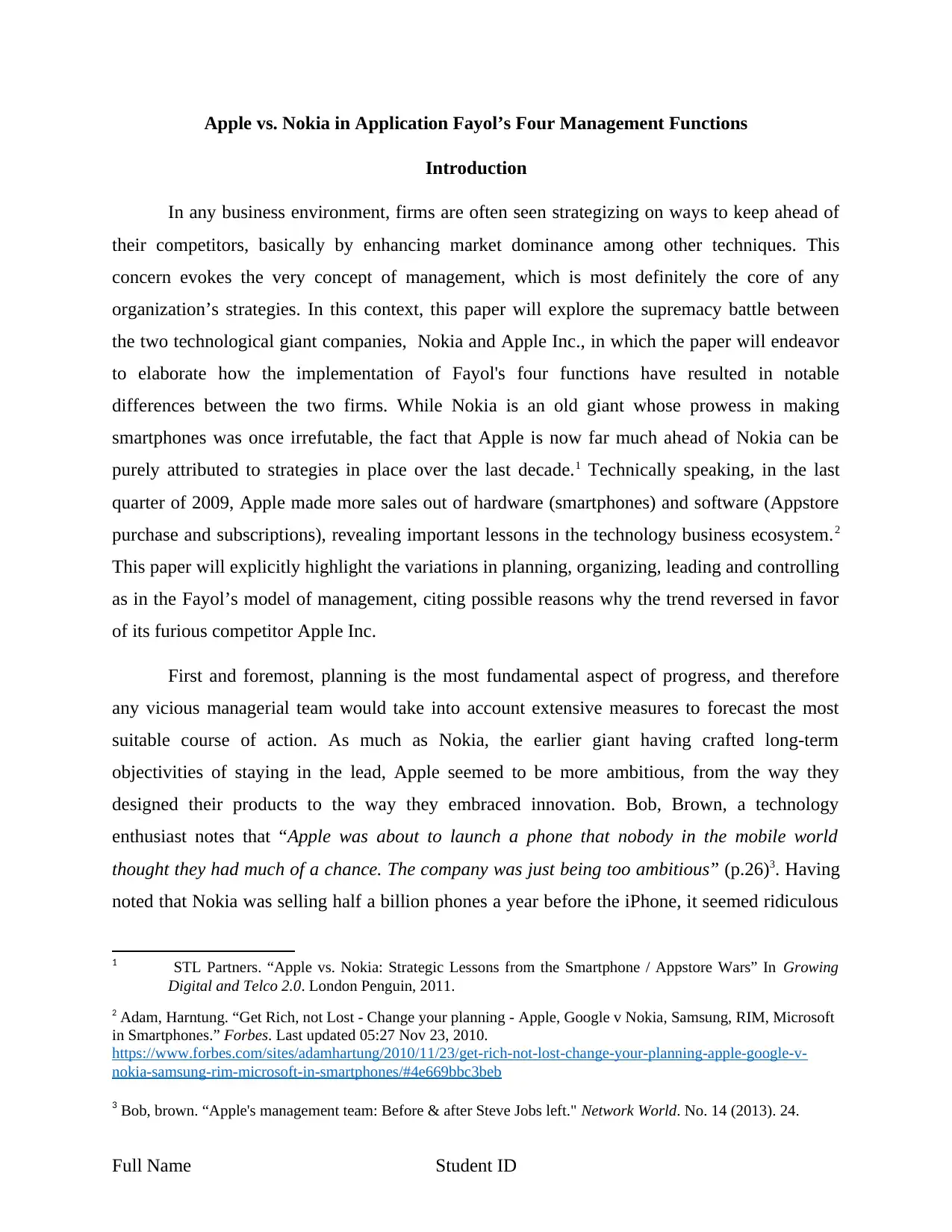
Apple vs. Nokia in Application Fayol’s Four Management Functions
Introduction
In any business environment, firms are often seen strategizing on ways to keep ahead of
their competitors, basically by enhancing market dominance among other techniques. This
concern evokes the very concept of management, which is most definitely the core of any
organization’s strategies. In this context, this paper will explore the supremacy battle between
the two technological giant companies, Nokia and Apple Inc., in which the paper will endeavor
to elaborate how the implementation of Fayol's four functions have resulted in notable
differences between the two firms. While Nokia is an old giant whose prowess in making
smartphones was once irrefutable, the fact that Apple is now far much ahead of Nokia can be
purely attributed to strategies in place over the last decade.1 Technically speaking, in the last
quarter of 2009, Apple made more sales out of hardware (smartphones) and software (Appstore
purchase and subscriptions), revealing important lessons in the technology business ecosystem.2
This paper will explicitly highlight the variations in planning, organizing, leading and controlling
as in the Fayol’s model of management, citing possible reasons why the trend reversed in favor
of its furious competitor Apple Inc.
First and foremost, planning is the most fundamental aspect of progress, and therefore
any vicious managerial team would take into account extensive measures to forecast the most
suitable course of action. As much as Nokia, the earlier giant having crafted long-term
objectivities of staying in the lead, Apple seemed to be more ambitious, from the way they
designed their products to the way they embraced innovation. Bob, Brown, a technology
enthusiast notes that “Apple was about to launch a phone that nobody in the mobile world
thought they had much of a chance. The company was just being too ambitious” (p.26)3. Having
noted that Nokia was selling half a billion phones a year before the iPhone, it seemed ridiculous
1 STL Partners. “Apple vs. Nokia: Strategic Lessons from the Smartphone / Appstore Wars” In Growing
Digital and Telco 2.0. London Penguin, 2011.
2 Adam, Harntung. “Get Rich, not Lost - Change your planning - Apple, Google v Nokia, Samsung, RIM, Microsoft
in Smartphones.” Forbes. Last updated 05:27 Nov 23, 2010.
https://www.forbes.com/sites/adamhartung/2010/11/23/get-rich-not-lost-change-your-planning-apple-google-v-
nokia-samsung-rim-microsoft-in-smartphones/#4e669bbc3beb
3 Bob, brown. “Apple's management team: Before & after Steve Jobs left." Network World. No. 14 (2013). 24.
Full Name Student ID
Introduction
In any business environment, firms are often seen strategizing on ways to keep ahead of
their competitors, basically by enhancing market dominance among other techniques. This
concern evokes the very concept of management, which is most definitely the core of any
organization’s strategies. In this context, this paper will explore the supremacy battle between
the two technological giant companies, Nokia and Apple Inc., in which the paper will endeavor
to elaborate how the implementation of Fayol's four functions have resulted in notable
differences between the two firms. While Nokia is an old giant whose prowess in making
smartphones was once irrefutable, the fact that Apple is now far much ahead of Nokia can be
purely attributed to strategies in place over the last decade.1 Technically speaking, in the last
quarter of 2009, Apple made more sales out of hardware (smartphones) and software (Appstore
purchase and subscriptions), revealing important lessons in the technology business ecosystem.2
This paper will explicitly highlight the variations in planning, organizing, leading and controlling
as in the Fayol’s model of management, citing possible reasons why the trend reversed in favor
of its furious competitor Apple Inc.
First and foremost, planning is the most fundamental aspect of progress, and therefore
any vicious managerial team would take into account extensive measures to forecast the most
suitable course of action. As much as Nokia, the earlier giant having crafted long-term
objectivities of staying in the lead, Apple seemed to be more ambitious, from the way they
designed their products to the way they embraced innovation. Bob, Brown, a technology
enthusiast notes that “Apple was about to launch a phone that nobody in the mobile world
thought they had much of a chance. The company was just being too ambitious” (p.26)3. Having
noted that Nokia was selling half a billion phones a year before the iPhone, it seemed ridiculous
1 STL Partners. “Apple vs. Nokia: Strategic Lessons from the Smartphone / Appstore Wars” In Growing
Digital and Telco 2.0. London Penguin, 2011.
2 Adam, Harntung. “Get Rich, not Lost - Change your planning - Apple, Google v Nokia, Samsung, RIM, Microsoft
in Smartphones.” Forbes. Last updated 05:27 Nov 23, 2010.
https://www.forbes.com/sites/adamhartung/2010/11/23/get-rich-not-lost-change-your-planning-apple-google-v-
nokia-samsung-rim-microsoft-in-smartphones/#4e669bbc3beb
3 Bob, brown. “Apple's management team: Before & after Steve Jobs left." Network World. No. 14 (2013). 24.
Full Name Student ID
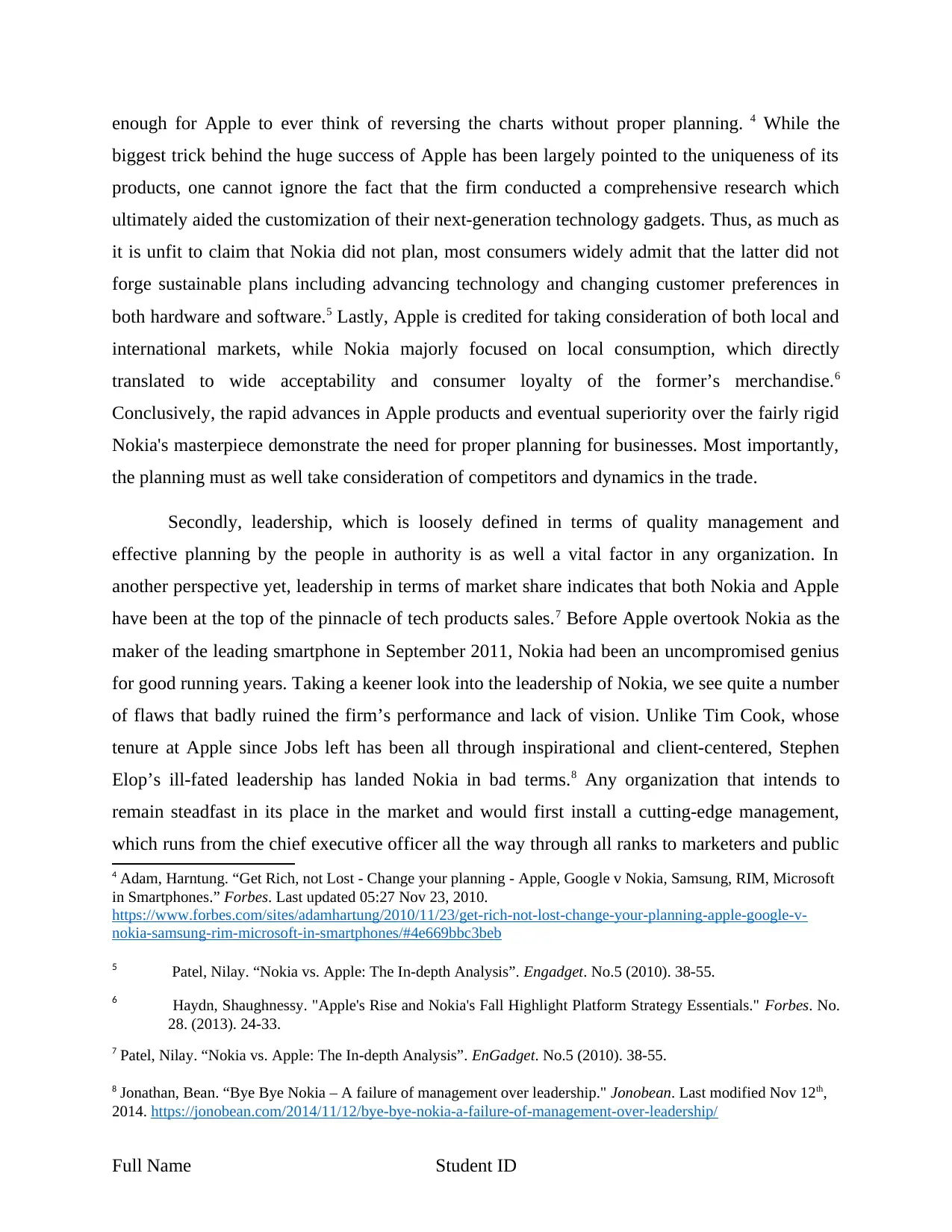
enough for Apple to ever think of reversing the charts without proper planning. 4 While the
biggest trick behind the huge success of Apple has been largely pointed to the uniqueness of its
products, one cannot ignore the fact that the firm conducted a comprehensive research which
ultimately aided the customization of their next-generation technology gadgets. Thus, as much as
it is unfit to claim that Nokia did not plan, most consumers widely admit that the latter did not
forge sustainable plans including advancing technology and changing customer preferences in
both hardware and software.5 Lastly, Apple is credited for taking consideration of both local and
international markets, while Nokia majorly focused on local consumption, which directly
translated to wide acceptability and consumer loyalty of the former’s merchandise.6
Conclusively, the rapid advances in Apple products and eventual superiority over the fairly rigid
Nokia's masterpiece demonstrate the need for proper planning for businesses. Most importantly,
the planning must as well take consideration of competitors and dynamics in the trade.
Secondly, leadership, which is loosely defined in terms of quality management and
effective planning by the people in authority is as well a vital factor in any organization. In
another perspective yet, leadership in terms of market share indicates that both Nokia and Apple
have been at the top of the pinnacle of tech products sales.7 Before Apple overtook Nokia as the
maker of the leading smartphone in September 2011, Nokia had been an uncompromised genius
for good running years. Taking a keener look into the leadership of Nokia, we see quite a number
of flaws that badly ruined the firm’s performance and lack of vision. Unlike Tim Cook, whose
tenure at Apple since Jobs left has been all through inspirational and client-centered, Stephen
Elop’s ill-fated leadership has landed Nokia in bad terms.8 Any organization that intends to
remain steadfast in its place in the market and would first install a cutting-edge management,
which runs from the chief executive officer all the way through all ranks to marketers and public
4 Adam, Harntung. “Get Rich, not Lost - Change your planning - Apple, Google v Nokia, Samsung, RIM, Microsoft
in Smartphones.” Forbes. Last updated 05:27 Nov 23, 2010.
https://www.forbes.com/sites/adamhartung/2010/11/23/get-rich-not-lost-change-your-planning-apple-google-v-
nokia-samsung-rim-microsoft-in-smartphones/#4e669bbc3beb
5 Patel, Nilay. “Nokia vs. Apple: The In-depth Analysis”. Engadget. No.5 (2010). 38-55.
6 Haydn, Shaughnessy. "Apple's Rise and Nokia's Fall Highlight Platform Strategy Essentials." Forbes. No.
28. (2013). 24-33.
7 Patel, Nilay. “Nokia vs. Apple: The In-depth Analysis”. EnGadget. No.5 (2010). 38-55.
8 Jonathan, Bean. “Bye Bye Nokia – A failure of management over leadership." Jonobean. Last modified Nov 12th,
2014. https://jonobean.com/2014/11/12/bye-bye-nokia-a-failure-of-management-over-leadership/
Full Name Student ID
biggest trick behind the huge success of Apple has been largely pointed to the uniqueness of its
products, one cannot ignore the fact that the firm conducted a comprehensive research which
ultimately aided the customization of their next-generation technology gadgets. Thus, as much as
it is unfit to claim that Nokia did not plan, most consumers widely admit that the latter did not
forge sustainable plans including advancing technology and changing customer preferences in
both hardware and software.5 Lastly, Apple is credited for taking consideration of both local and
international markets, while Nokia majorly focused on local consumption, which directly
translated to wide acceptability and consumer loyalty of the former’s merchandise.6
Conclusively, the rapid advances in Apple products and eventual superiority over the fairly rigid
Nokia's masterpiece demonstrate the need for proper planning for businesses. Most importantly,
the planning must as well take consideration of competitors and dynamics in the trade.
Secondly, leadership, which is loosely defined in terms of quality management and
effective planning by the people in authority is as well a vital factor in any organization. In
another perspective yet, leadership in terms of market share indicates that both Nokia and Apple
have been at the top of the pinnacle of tech products sales.7 Before Apple overtook Nokia as the
maker of the leading smartphone in September 2011, Nokia had been an uncompromised genius
for good running years. Taking a keener look into the leadership of Nokia, we see quite a number
of flaws that badly ruined the firm’s performance and lack of vision. Unlike Tim Cook, whose
tenure at Apple since Jobs left has been all through inspirational and client-centered, Stephen
Elop’s ill-fated leadership has landed Nokia in bad terms.8 Any organization that intends to
remain steadfast in its place in the market and would first install a cutting-edge management,
which runs from the chief executive officer all the way through all ranks to marketers and public
4 Adam, Harntung. “Get Rich, not Lost - Change your planning - Apple, Google v Nokia, Samsung, RIM, Microsoft
in Smartphones.” Forbes. Last updated 05:27 Nov 23, 2010.
https://www.forbes.com/sites/adamhartung/2010/11/23/get-rich-not-lost-change-your-planning-apple-google-v-
nokia-samsung-rim-microsoft-in-smartphones/#4e669bbc3beb
5 Patel, Nilay. “Nokia vs. Apple: The In-depth Analysis”. Engadget. No.5 (2010). 38-55.
6 Haydn, Shaughnessy. "Apple's Rise and Nokia's Fall Highlight Platform Strategy Essentials." Forbes. No.
28. (2013). 24-33.
7 Patel, Nilay. “Nokia vs. Apple: The In-depth Analysis”. EnGadget. No.5 (2010). 38-55.
8 Jonathan, Bean. “Bye Bye Nokia – A failure of management over leadership." Jonobean. Last modified Nov 12th,
2014. https://jonobean.com/2014/11/12/bye-bye-nokia-a-failure-of-management-over-leadership/
Full Name Student ID
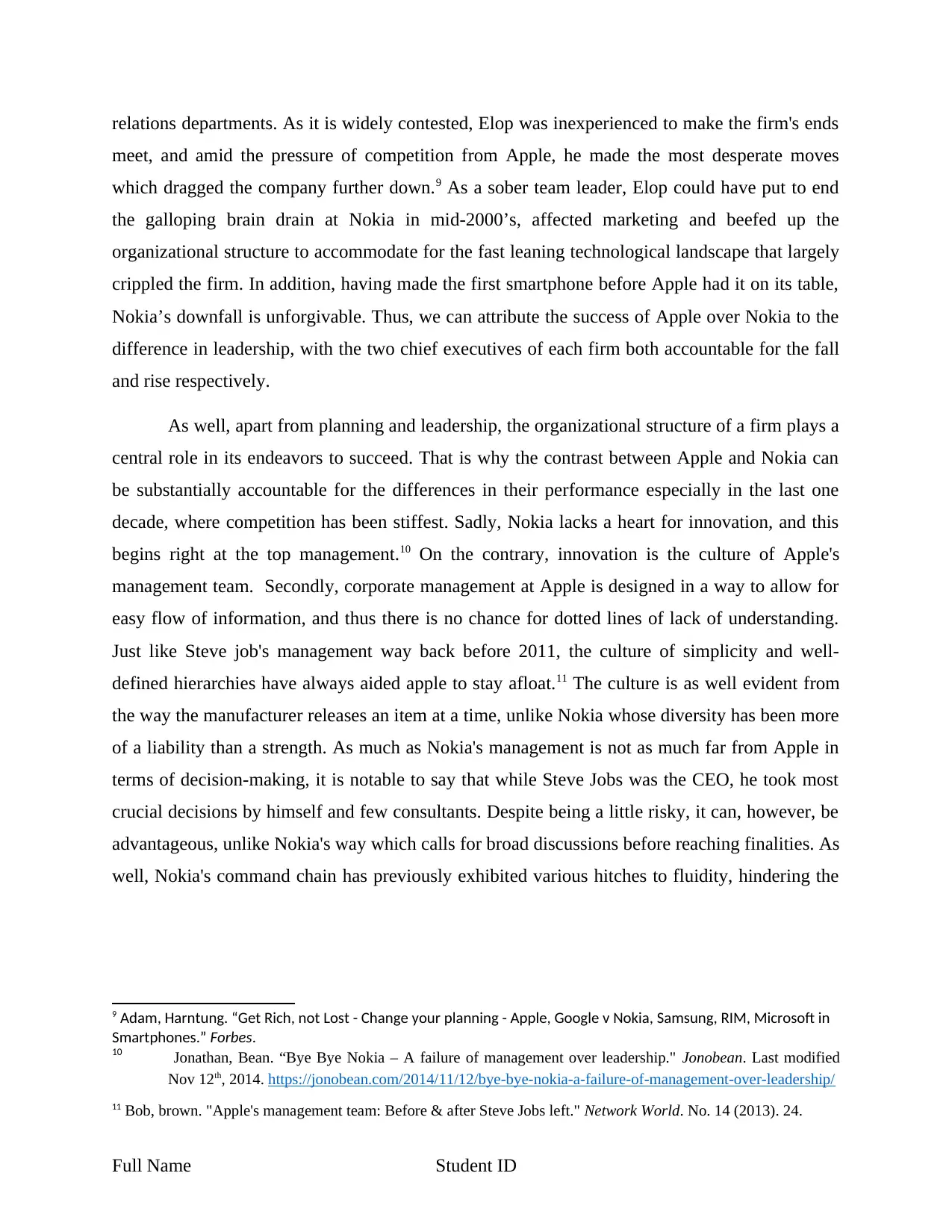
relations departments. As it is widely contested, Elop was inexperienced to make the firm's ends
meet, and amid the pressure of competition from Apple, he made the most desperate moves
which dragged the company further down.9 As a sober team leader, Elop could have put to end
the galloping brain drain at Nokia in mid-2000’s, affected marketing and beefed up the
organizational structure to accommodate for the fast leaning technological landscape that largely
crippled the firm. In addition, having made the first smartphone before Apple had it on its table,
Nokia’s downfall is unforgivable. Thus, we can attribute the success of Apple over Nokia to the
difference in leadership, with the two chief executives of each firm both accountable for the fall
and rise respectively.
As well, apart from planning and leadership, the organizational structure of a firm plays a
central role in its endeavors to succeed. That is why the contrast between Apple and Nokia can
be substantially accountable for the differences in their performance especially in the last one
decade, where competition has been stiffest. Sadly, Nokia lacks a heart for innovation, and this
begins right at the top management.10 On the contrary, innovation is the culture of Apple's
management team. Secondly, corporate management at Apple is designed in a way to allow for
easy flow of information, and thus there is no chance for dotted lines of lack of understanding.
Just like Steve job's management way back before 2011, the culture of simplicity and well-
defined hierarchies have always aided apple to stay afloat.11 The culture is as well evident from
the way the manufacturer releases an item at a time, unlike Nokia whose diversity has been more
of a liability than a strength. As much as Nokia's management is not as much far from Apple in
terms of decision-making, it is notable to say that while Steve Jobs was the CEO, he took most
crucial decisions by himself and few consultants. Despite being a little risky, it can, however, be
advantageous, unlike Nokia's way which calls for broad discussions before reaching finalities. As
well, Nokia's command chain has previously exhibited various hitches to fluidity, hindering the
9 Adam, Harntung. “Get Rich, not Lost - Change your planning - Apple, Google v Nokia, Samsung, RIM, Microsoft in
Smartphones.” Forbes.
10 Jonathan, Bean. “Bye Bye Nokia – A failure of management over leadership." Jonobean. Last modified
Nov 12th, 2014. https://jonobean.com/2014/11/12/bye-bye-nokia-a-failure-of-management-over-leadership/
11 Bob, brown. "Apple's management team: Before & after Steve Jobs left." Network World. No. 14 (2013). 24.
Full Name Student ID
meet, and amid the pressure of competition from Apple, he made the most desperate moves
which dragged the company further down.9 As a sober team leader, Elop could have put to end
the galloping brain drain at Nokia in mid-2000’s, affected marketing and beefed up the
organizational structure to accommodate for the fast leaning technological landscape that largely
crippled the firm. In addition, having made the first smartphone before Apple had it on its table,
Nokia’s downfall is unforgivable. Thus, we can attribute the success of Apple over Nokia to the
difference in leadership, with the two chief executives of each firm both accountable for the fall
and rise respectively.
As well, apart from planning and leadership, the organizational structure of a firm plays a
central role in its endeavors to succeed. That is why the contrast between Apple and Nokia can
be substantially accountable for the differences in their performance especially in the last one
decade, where competition has been stiffest. Sadly, Nokia lacks a heart for innovation, and this
begins right at the top management.10 On the contrary, innovation is the culture of Apple's
management team. Secondly, corporate management at Apple is designed in a way to allow for
easy flow of information, and thus there is no chance for dotted lines of lack of understanding.
Just like Steve job's management way back before 2011, the culture of simplicity and well-
defined hierarchies have always aided apple to stay afloat.11 The culture is as well evident from
the way the manufacturer releases an item at a time, unlike Nokia whose diversity has been more
of a liability than a strength. As much as Nokia's management is not as much far from Apple in
terms of decision-making, it is notable to say that while Steve Jobs was the CEO, he took most
crucial decisions by himself and few consultants. Despite being a little risky, it can, however, be
advantageous, unlike Nokia's way which calls for broad discussions before reaching finalities. As
well, Nokia's command chain has previously exhibited various hitches to fluidity, hindering the
9 Adam, Harntung. “Get Rich, not Lost - Change your planning - Apple, Google v Nokia, Samsung, RIM, Microsoft in
Smartphones.” Forbes.
10 Jonathan, Bean. “Bye Bye Nokia – A failure of management over leadership." Jonobean. Last modified
Nov 12th, 2014. https://jonobean.com/2014/11/12/bye-bye-nokia-a-failure-of-management-over-leadership/
11 Bob, brown. "Apple's management team: Before & after Steve Jobs left." Network World. No. 14 (2013). 24.
Full Name Student ID
Secure Best Marks with AI Grader
Need help grading? Try our AI Grader for instant feedback on your assignments.
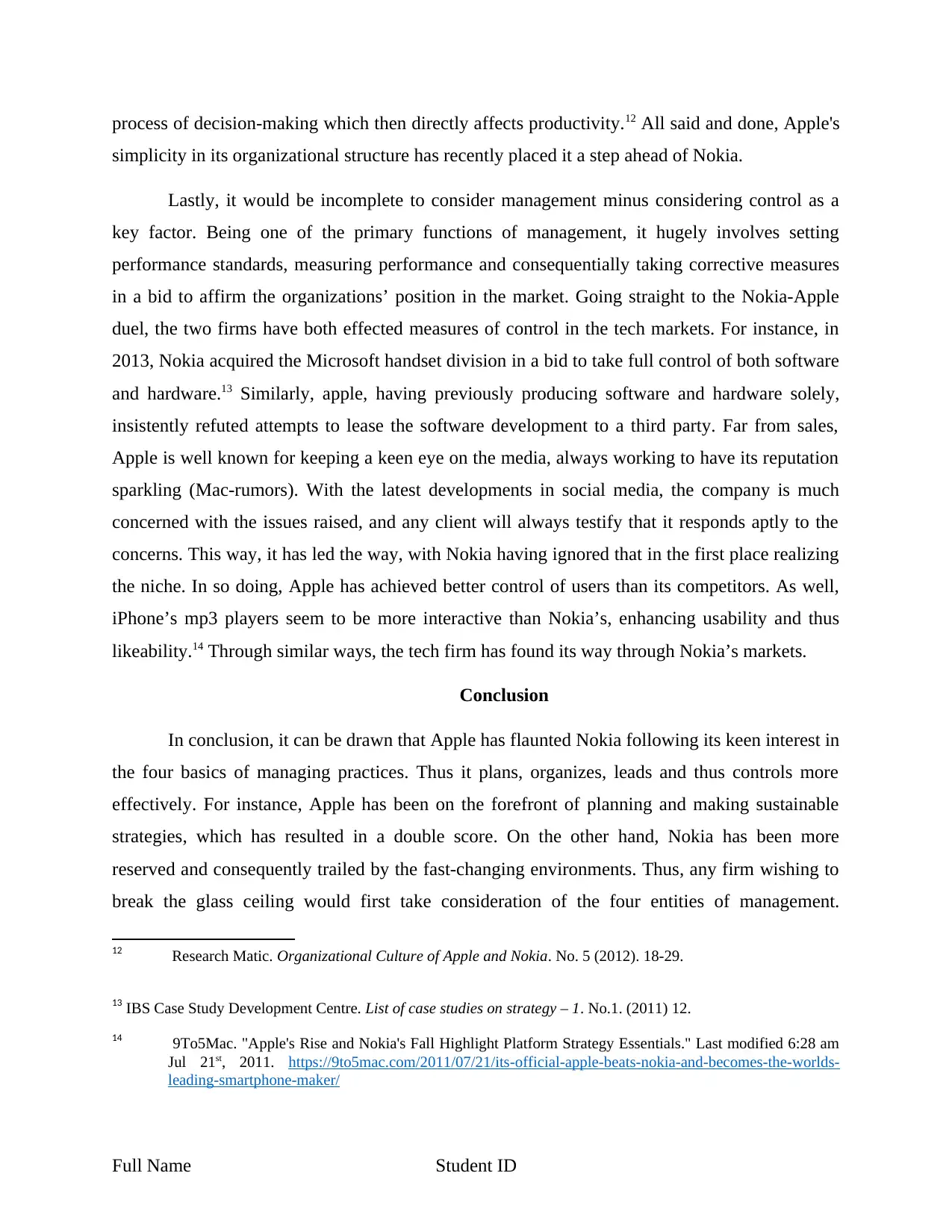
process of decision-making which then directly affects productivity.12 All said and done, Apple's
simplicity in its organizational structure has recently placed it a step ahead of Nokia.
Lastly, it would be incomplete to consider management minus considering control as a
key factor. Being one of the primary functions of management, it hugely involves setting
performance standards, measuring performance and consequentially taking corrective measures
in a bid to affirm the organizations’ position in the market. Going straight to the Nokia-Apple
duel, the two firms have both effected measures of control in the tech markets. For instance, in
2013, Nokia acquired the Microsoft handset division in a bid to take full control of both software
and hardware.13 Similarly, apple, having previously producing software and hardware solely,
insistently refuted attempts to lease the software development to a third party. Far from sales,
Apple is well known for keeping a keen eye on the media, always working to have its reputation
sparkling (Mac-rumors). With the latest developments in social media, the company is much
concerned with the issues raised, and any client will always testify that it responds aptly to the
concerns. This way, it has led the way, with Nokia having ignored that in the first place realizing
the niche. In so doing, Apple has achieved better control of users than its competitors. As well,
iPhone’s mp3 players seem to be more interactive than Nokia’s, enhancing usability and thus
likeability.14 Through similar ways, the tech firm has found its way through Nokia’s markets.
Conclusion
In conclusion, it can be drawn that Apple has flaunted Nokia following its keen interest in
the four basics of managing practices. Thus it plans, organizes, leads and thus controls more
effectively. For instance, Apple has been on the forefront of planning and making sustainable
strategies, which has resulted in a double score. On the other hand, Nokia has been more
reserved and consequently trailed by the fast-changing environments. Thus, any firm wishing to
break the glass ceiling would first take consideration of the four entities of management.
12 Research Matic. Organizational Culture of Apple and Nokia. No. 5 (2012). 18-29.
13 IBS Case Study Development Centre. List of case studies on strategy – 1. No.1. (2011) 12.
14 9To5Mac. "Apple's Rise and Nokia's Fall Highlight Platform Strategy Essentials." Last modified 6:28 am
Jul 21st, 2011. https://9to5mac.com/2011/07/21/its-official-apple-beats-nokia-and-becomes-the-worlds-
leading-smartphone-maker/
Full Name Student ID
simplicity in its organizational structure has recently placed it a step ahead of Nokia.
Lastly, it would be incomplete to consider management minus considering control as a
key factor. Being one of the primary functions of management, it hugely involves setting
performance standards, measuring performance and consequentially taking corrective measures
in a bid to affirm the organizations’ position in the market. Going straight to the Nokia-Apple
duel, the two firms have both effected measures of control in the tech markets. For instance, in
2013, Nokia acquired the Microsoft handset division in a bid to take full control of both software
and hardware.13 Similarly, apple, having previously producing software and hardware solely,
insistently refuted attempts to lease the software development to a third party. Far from sales,
Apple is well known for keeping a keen eye on the media, always working to have its reputation
sparkling (Mac-rumors). With the latest developments in social media, the company is much
concerned with the issues raised, and any client will always testify that it responds aptly to the
concerns. This way, it has led the way, with Nokia having ignored that in the first place realizing
the niche. In so doing, Apple has achieved better control of users than its competitors. As well,
iPhone’s mp3 players seem to be more interactive than Nokia’s, enhancing usability and thus
likeability.14 Through similar ways, the tech firm has found its way through Nokia’s markets.
Conclusion
In conclusion, it can be drawn that Apple has flaunted Nokia following its keen interest in
the four basics of managing practices. Thus it plans, organizes, leads and thus controls more
effectively. For instance, Apple has been on the forefront of planning and making sustainable
strategies, which has resulted in a double score. On the other hand, Nokia has been more
reserved and consequently trailed by the fast-changing environments. Thus, any firm wishing to
break the glass ceiling would first take consideration of the four entities of management.
12 Research Matic. Organizational Culture of Apple and Nokia. No. 5 (2012). 18-29.
13 IBS Case Study Development Centre. List of case studies on strategy – 1. No.1. (2011) 12.
14 9To5Mac. "Apple's Rise and Nokia's Fall Highlight Platform Strategy Essentials." Last modified 6:28 am
Jul 21st, 2011. https://9to5mac.com/2011/07/21/its-official-apple-beats-nokia-and-becomes-the-worlds-
leading-smartphone-maker/
Full Name Student ID

Additionally, just like in the above context, any firm in the lead must be able to make well-
thought and dynamic strategies that can aid it to survive an onslaught by a younger entrant.
Full Name Student ID
thought and dynamic strategies that can aid it to survive an onslaught by a younger entrant.
Full Name Student ID
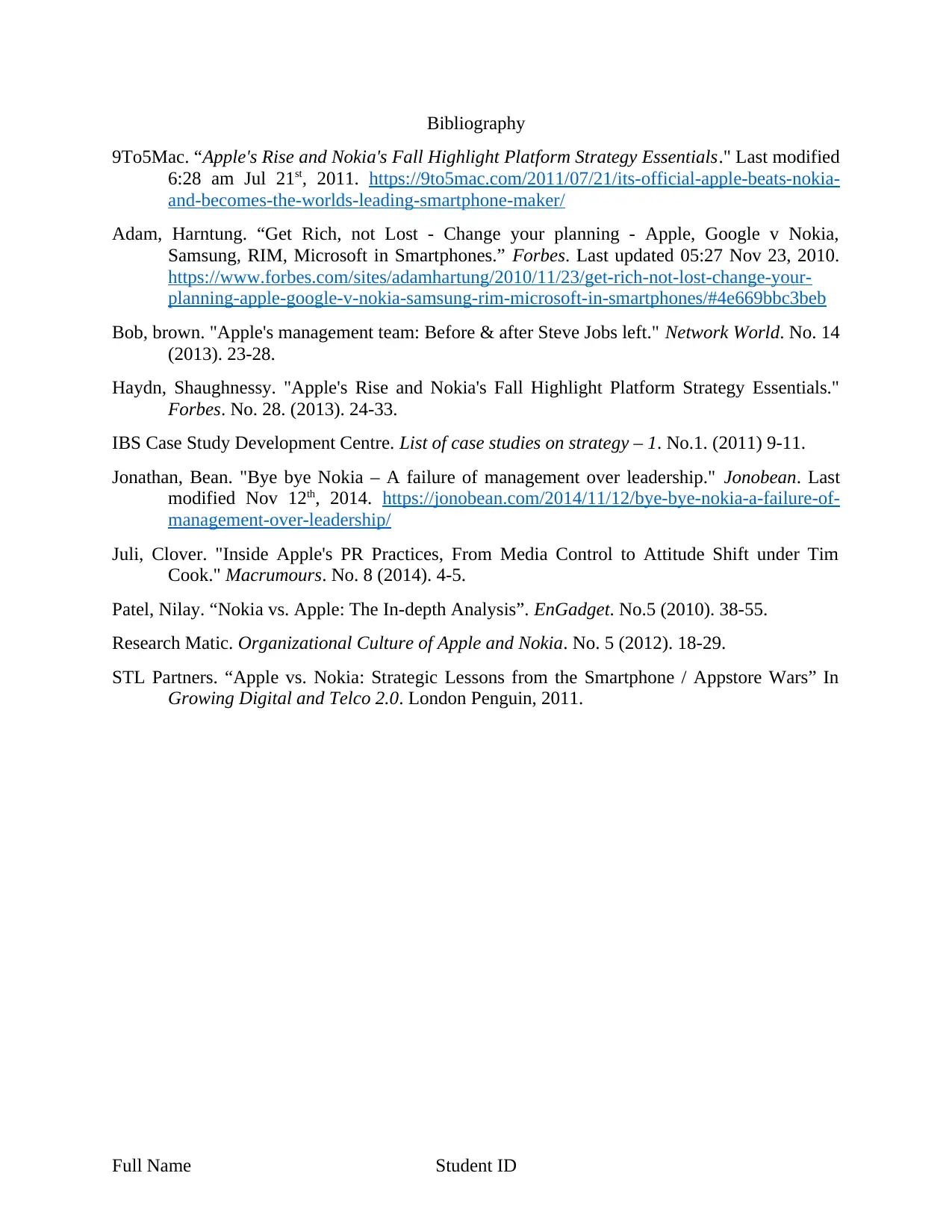
Bibliography
9To5Mac. “Apple's Rise and Nokia's Fall Highlight Platform Strategy Essentials." Last modified
6:28 am Jul 21st, 2011. https://9to5mac.com/2011/07/21/its-official-apple-beats-nokia-
and-becomes-the-worlds-leading-smartphone-maker/
Adam, Harntung. “Get Rich, not Lost - Change your planning - Apple, Google v Nokia,
Samsung, RIM, Microsoft in Smartphones.” Forbes. Last updated 05:27 Nov 23, 2010.
https://www.forbes.com/sites/adamhartung/2010/11/23/get-rich-not-lost-change-your-
planning-apple-google-v-nokia-samsung-rim-microsoft-in-smartphones/#4e669bbc3beb
Bob, brown. "Apple's management team: Before & after Steve Jobs left." Network World. No. 14
(2013). 23-28.
Haydn, Shaughnessy. "Apple's Rise and Nokia's Fall Highlight Platform Strategy Essentials."
Forbes. No. 28. (2013). 24-33.
IBS Case Study Development Centre. List of case studies on strategy – 1. No.1. (2011) 9-11.
Jonathan, Bean. "Bye bye Nokia – A failure of management over leadership." Jonobean. Last
modified Nov 12th, 2014. https://jonobean.com/2014/11/12/bye-bye-nokia-a-failure-of-
management-over-leadership/
Juli, Clover. "Inside Apple's PR Practices, From Media Control to Attitude Shift under Tim
Cook." Macrumours. No. 8 (2014). 4-5.
Patel, Nilay. “Nokia vs. Apple: The In-depth Analysis”. EnGadget. No.5 (2010). 38-55.
Research Matic. Organizational Culture of Apple and Nokia. No. 5 (2012). 18-29.
STL Partners. “Apple vs. Nokia: Strategic Lessons from the Smartphone / Appstore Wars” In
Growing Digital and Telco 2.0. London Penguin, 2011.
Full Name Student ID
9To5Mac. “Apple's Rise and Nokia's Fall Highlight Platform Strategy Essentials." Last modified
6:28 am Jul 21st, 2011. https://9to5mac.com/2011/07/21/its-official-apple-beats-nokia-
and-becomes-the-worlds-leading-smartphone-maker/
Adam, Harntung. “Get Rich, not Lost - Change your planning - Apple, Google v Nokia,
Samsung, RIM, Microsoft in Smartphones.” Forbes. Last updated 05:27 Nov 23, 2010.
https://www.forbes.com/sites/adamhartung/2010/11/23/get-rich-not-lost-change-your-
planning-apple-google-v-nokia-samsung-rim-microsoft-in-smartphones/#4e669bbc3beb
Bob, brown. "Apple's management team: Before & after Steve Jobs left." Network World. No. 14
(2013). 23-28.
Haydn, Shaughnessy. "Apple's Rise and Nokia's Fall Highlight Platform Strategy Essentials."
Forbes. No. 28. (2013). 24-33.
IBS Case Study Development Centre. List of case studies on strategy – 1. No.1. (2011) 9-11.
Jonathan, Bean. "Bye bye Nokia – A failure of management over leadership." Jonobean. Last
modified Nov 12th, 2014. https://jonobean.com/2014/11/12/bye-bye-nokia-a-failure-of-
management-over-leadership/
Juli, Clover. "Inside Apple's PR Practices, From Media Control to Attitude Shift under Tim
Cook." Macrumours. No. 8 (2014). 4-5.
Patel, Nilay. “Nokia vs. Apple: The In-depth Analysis”. EnGadget. No.5 (2010). 38-55.
Research Matic. Organizational Culture of Apple and Nokia. No. 5 (2012). 18-29.
STL Partners. “Apple vs. Nokia: Strategic Lessons from the Smartphone / Appstore Wars” In
Growing Digital and Telco 2.0. London Penguin, 2011.
Full Name Student ID
1 out of 7
Related Documents
Your All-in-One AI-Powered Toolkit for Academic Success.
+13062052269
info@desklib.com
Available 24*7 on WhatsApp / Email
![[object Object]](/_next/static/media/star-bottom.7253800d.svg)
Unlock your academic potential
© 2024 | Zucol Services PVT LTD | All rights reserved.





